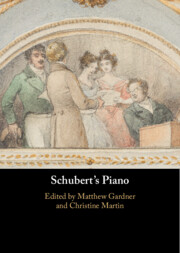Book contents
- Schubert’s Piano
- Schubert’s Piano
- Copyright page
- Contents
- Figures
- Tables
- Music Examples
- Notes on Contributors
- Acknowledgements
- Abbreviations and Conventions
- Introduction
- Part I The Piano in Schubert’s World
- Part II Instruments and Performance
- Part III Sound and Musical Imagery
- 8 Schubert as Balladeer
- 9 The Piano and Musical Imagery in Schubert’s Lieder
- 10 Franz Schubert, Death and the Gothic
- 11 Una Corda: Beethoven’s and Schubert’s Exploration of the Piano’s Sonority as a Structural Resource
- Part IV Understanding Schubert’s Writing for the Piano
- Select Bibliography
- Index
11 - Una Corda: Beethoven’s and Schubert’s Exploration of the Piano’s Sonority as a Structural Resource
from Part III - Sound and Musical Imagery
Published online by Cambridge University Press: 31 August 2024
- Schubert’s Piano
- Schubert’s Piano
- Copyright page
- Contents
- Figures
- Tables
- Music Examples
- Notes on Contributors
- Acknowledgements
- Abbreviations and Conventions
- Introduction
- Part I The Piano in Schubert’s World
- Part II Instruments and Performance
- Part III Sound and Musical Imagery
- 8 Schubert as Balladeer
- 9 The Piano and Musical Imagery in Schubert’s Lieder
- 10 Franz Schubert, Death and the Gothic
- 11 Una Corda: Beethoven’s and Schubert’s Exploration of the Piano’s Sonority as a Structural Resource
- Part IV Understanding Schubert’s Writing for the Piano
- Select Bibliography
- Index
Summary
From 1810 to 1830, Viennese piano construction evolved in an attempt to combine the special sonority of Viennese instruments with new advances in technology. One important factor was the possibility of varying the sound between full and reduced or dampened action. A particularly striking change of sound could be produced by the soft or una corda pedal, which shifted the hammer rail so that the hammers struck only one rather than the standard three strings of a triple-strung piano. Although detailed knowledge of which composers wrote which works for which instrument is lacking, hypotheses can be advanced regarding the influence of the action of certain instruments on compositional style. A comparison of works by two composers from different generations – one earlier (Beethoven) and another later (Mendelssohn, who had a predilection for Viennese instruments in his youth) – sheds light on several peculiarities of Schubert’s piano music. Beethoven’s late works and Schubert’s works of the 1820s both exploit this potential in order to coordinate sonority and structure. However, the two composers differ in one key respect: Beethoven tended to use the sonic contrasts he exploited (and meticulously notated) to articulate the work’s architecture, whereas Schubert used them to refine atmosphere and mood.
Keywords
- Type
- Chapter
- Information
- Schubert's Piano , pp. 219 - 238Publisher: Cambridge University PressPrint publication year: 2024

